Factors influencing employee commitment through the mediator job satisfaction - A study of office staffs in Ho Chi Minh city
This paper examines the relationship between employee-Related factors and employee commitment through the mediator job satisfaction of office employees in Ho Chi Minh City. The conceptual model is adapted from previous research and Herzberg’s two-factor theory. The theory emphasized the certain elements belonging to two categories intrinsic and extrinsic value that lead to people’s satisfaction. Four factors include Training, Pay, Working Environment, and Leadership. The data is collected through questionnaires from 422 office staffs in Ho Chi Minh; then only 395 qualified responses are analyzed. SPSS and AMOS tools are used to analyze the data through Reliability test, Model fit test, SEM method. The final result reveals that all factors are significantly related to Job Satisfaction meaning these variables also have indirect positive relationship with Employee Commitment through the mediator. This research is useful for organizations which aim to build the commitment strategy for keeping best talents in the company
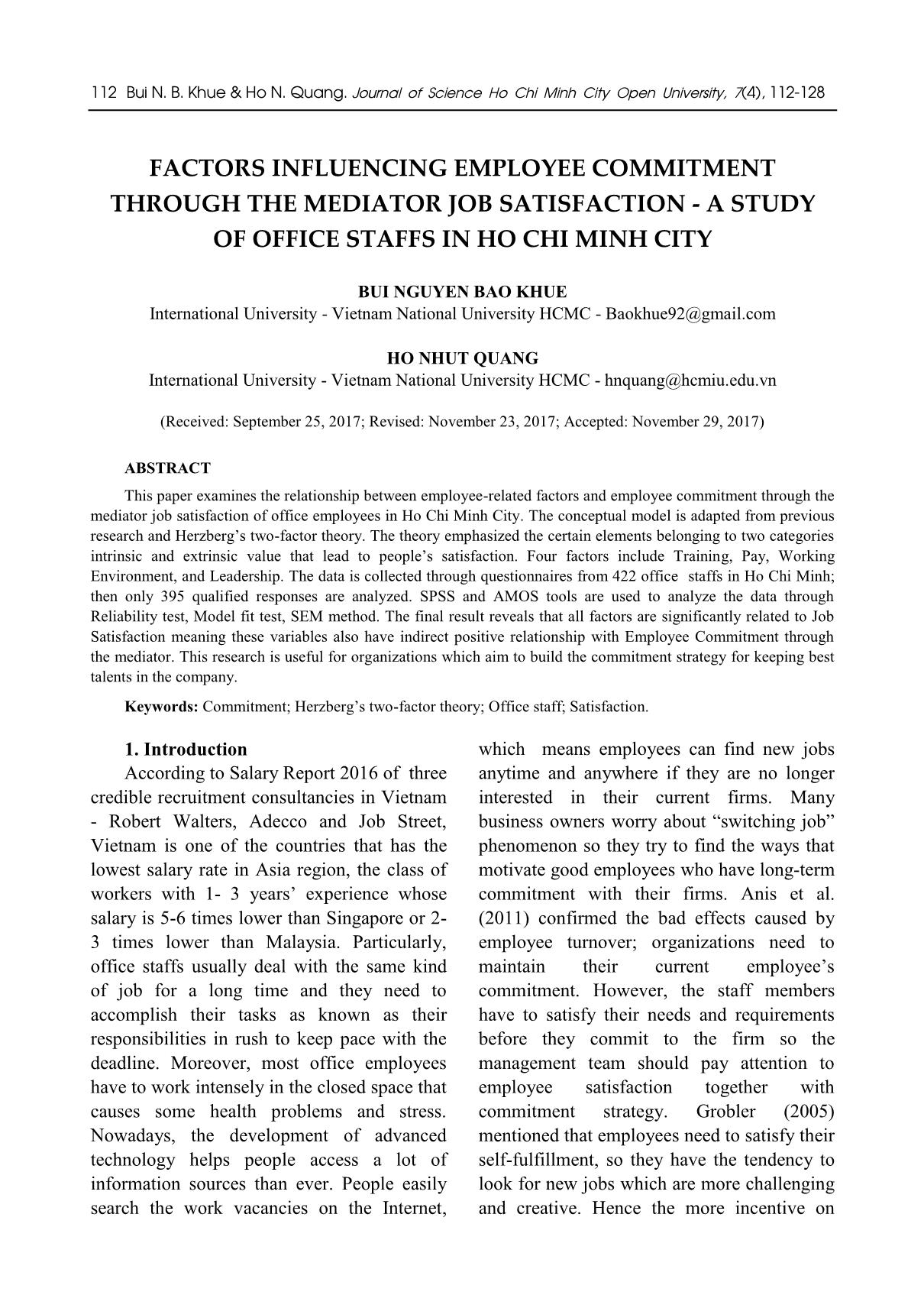
Trang 1
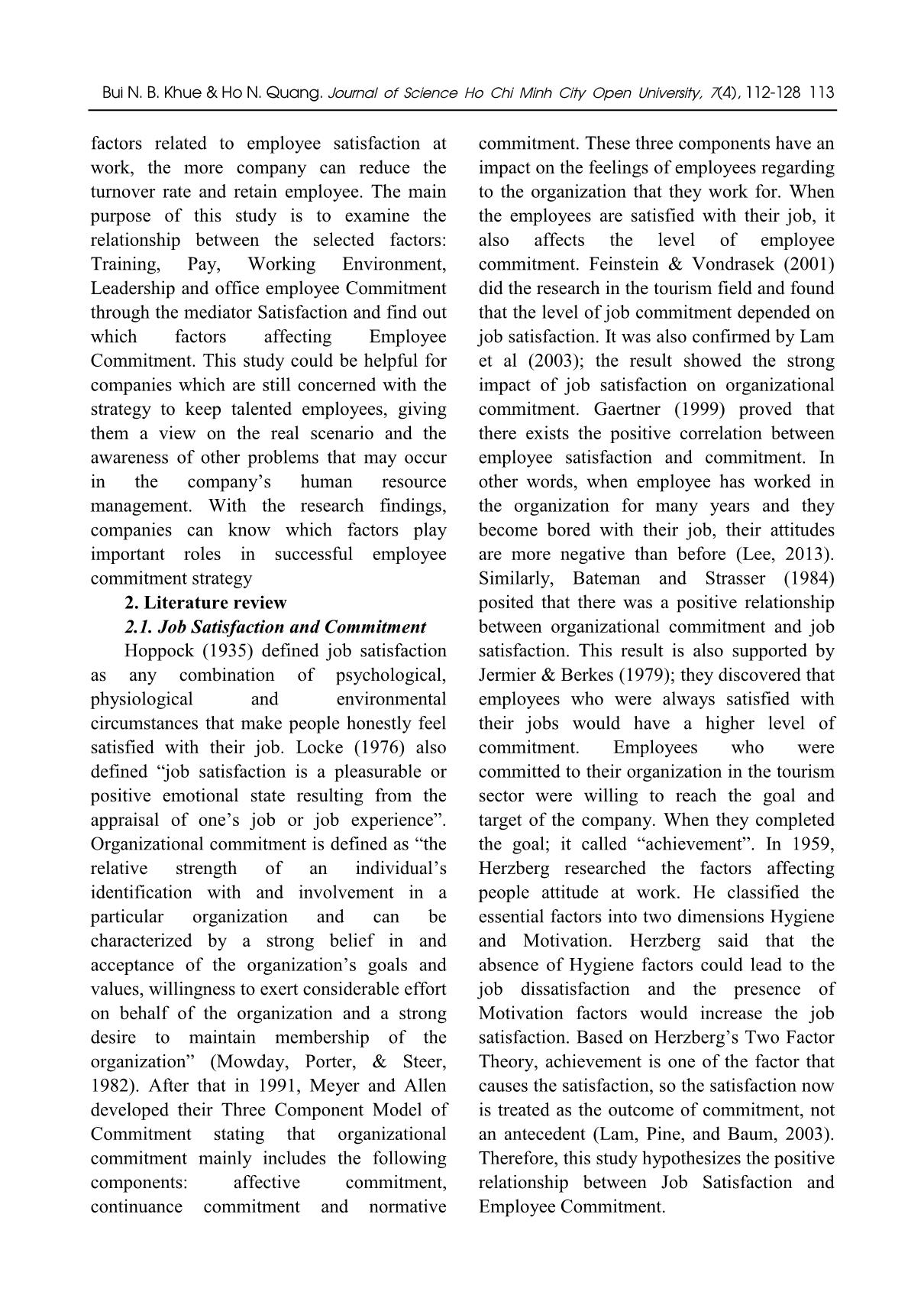
Trang 2
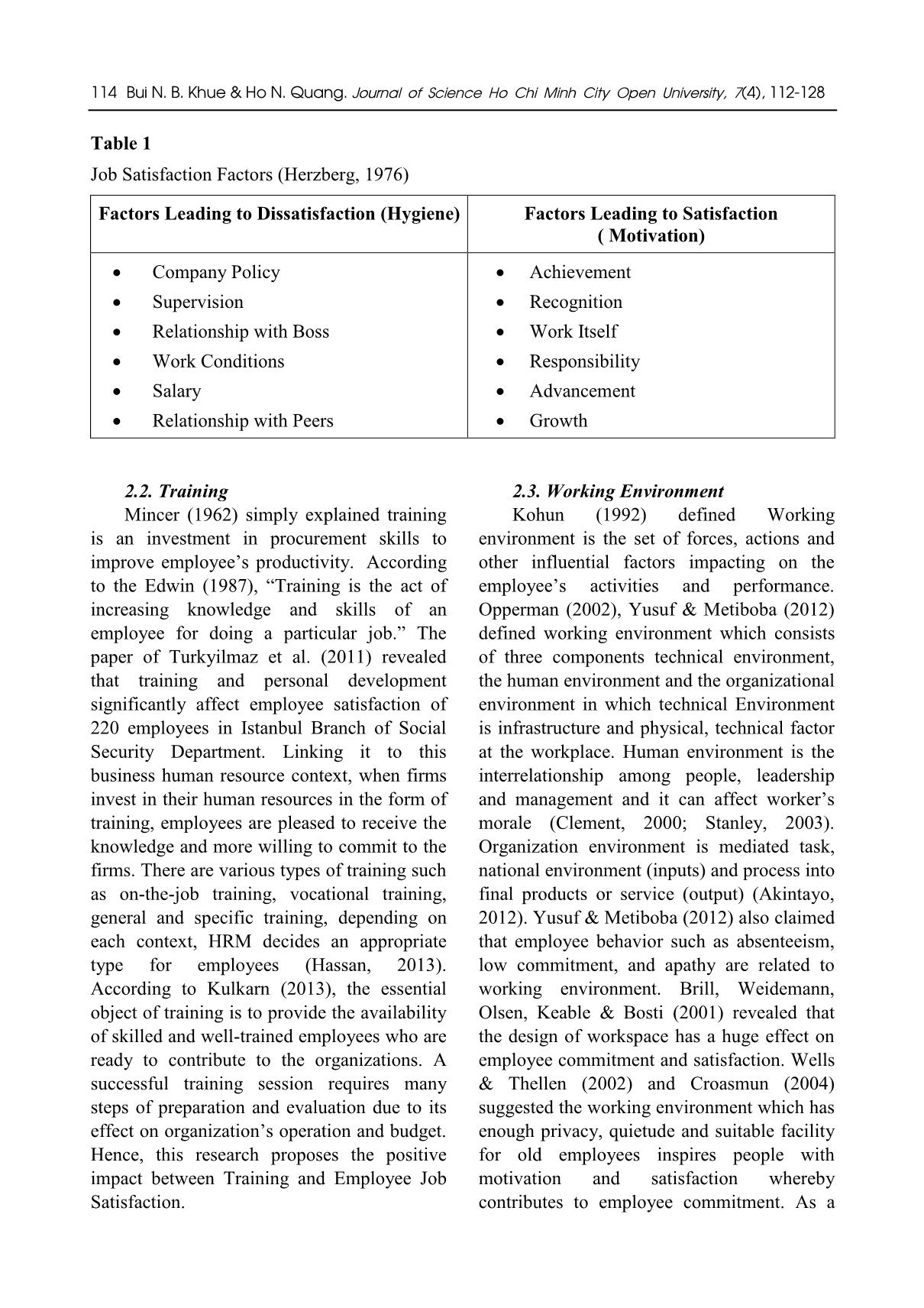
Trang 3
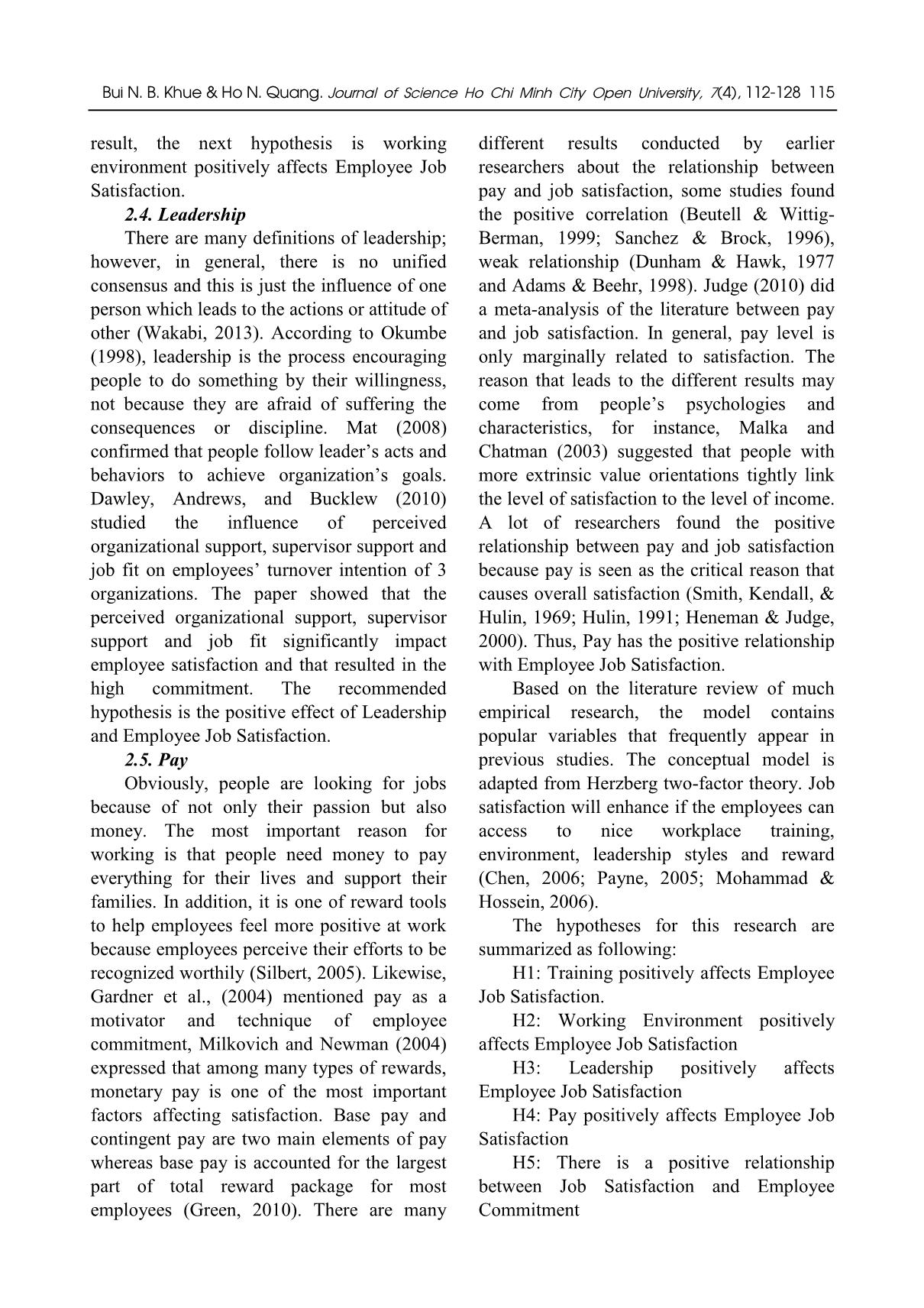
Trang 4
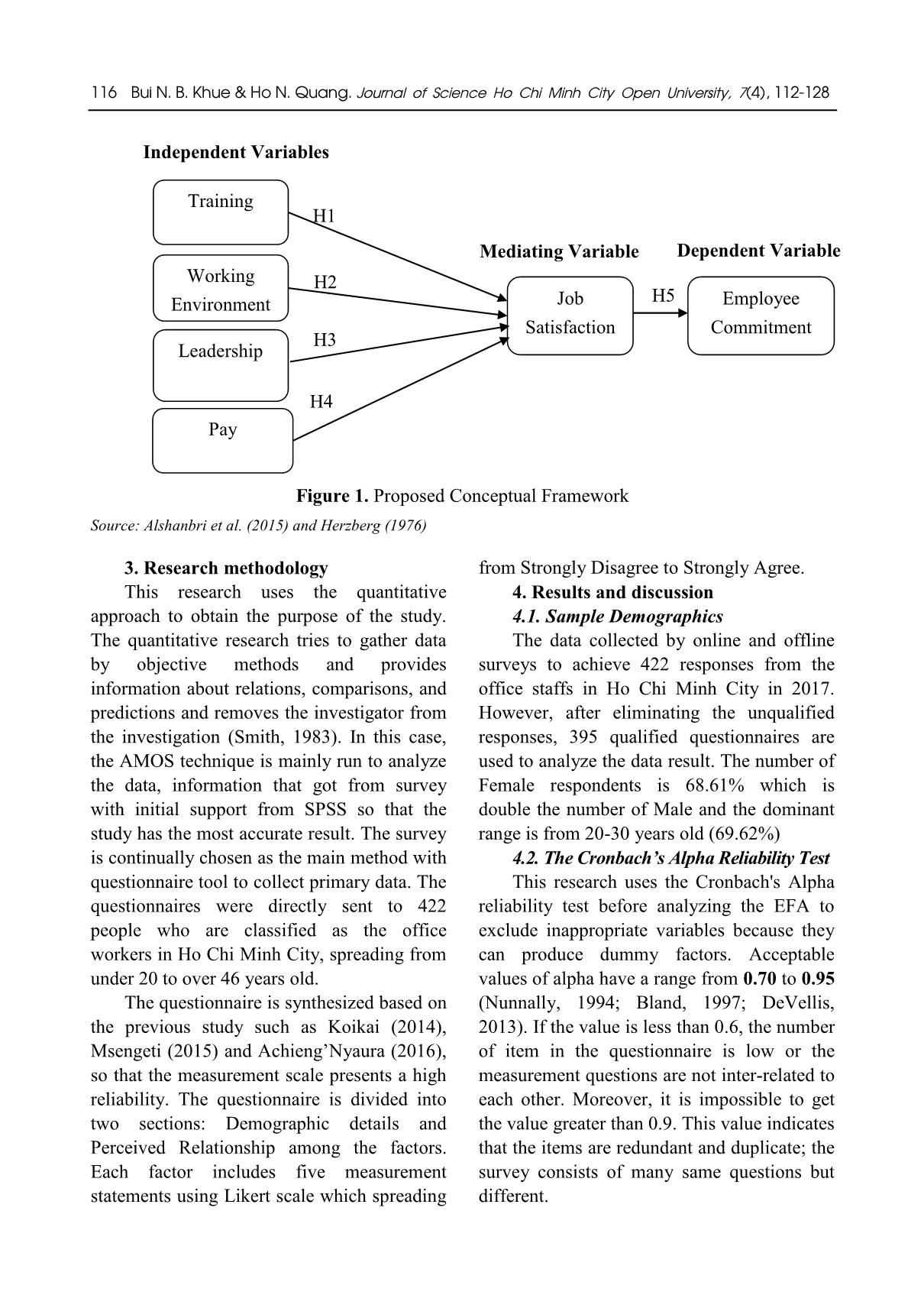
Trang 5
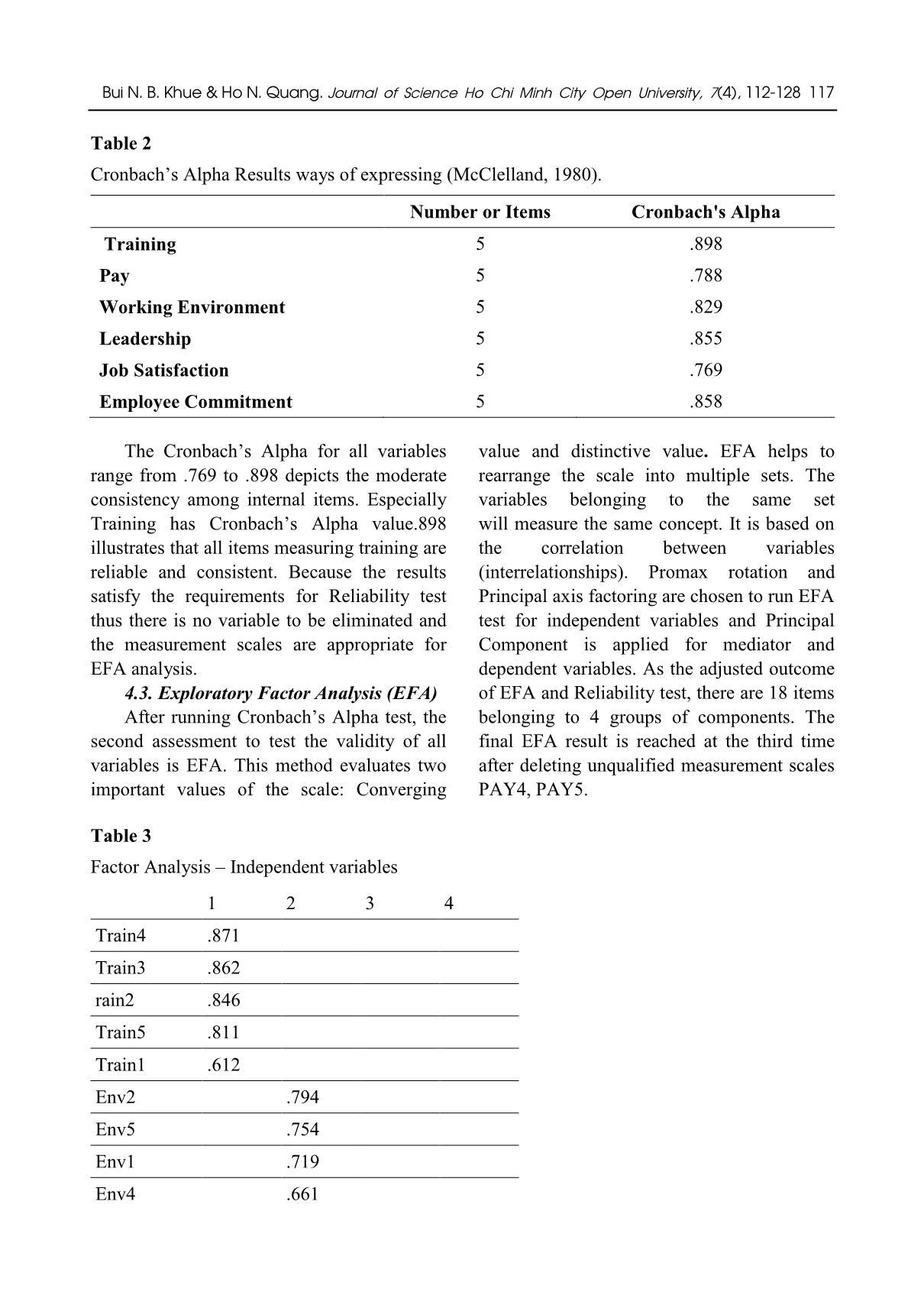
Trang 6
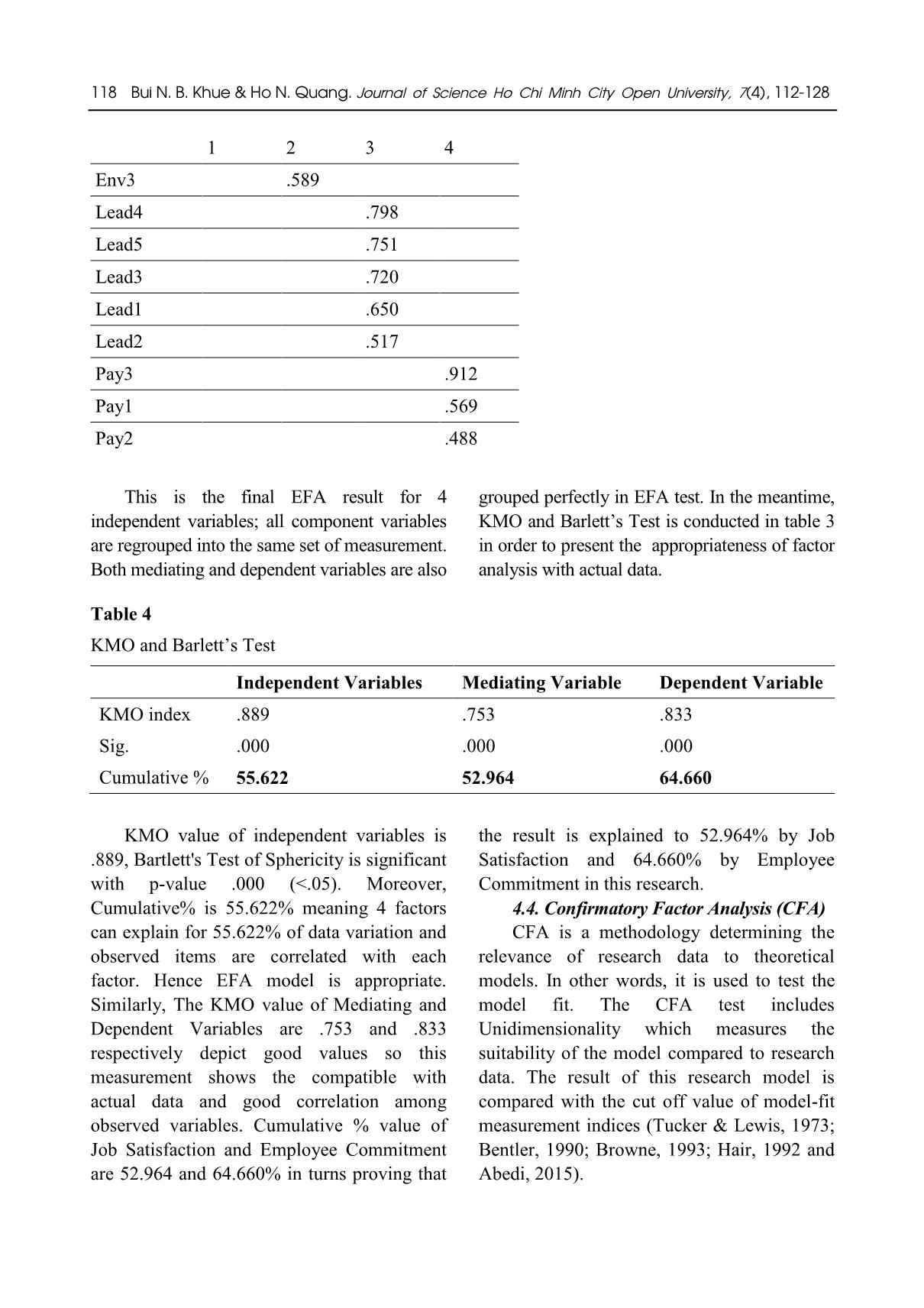
Trang 7
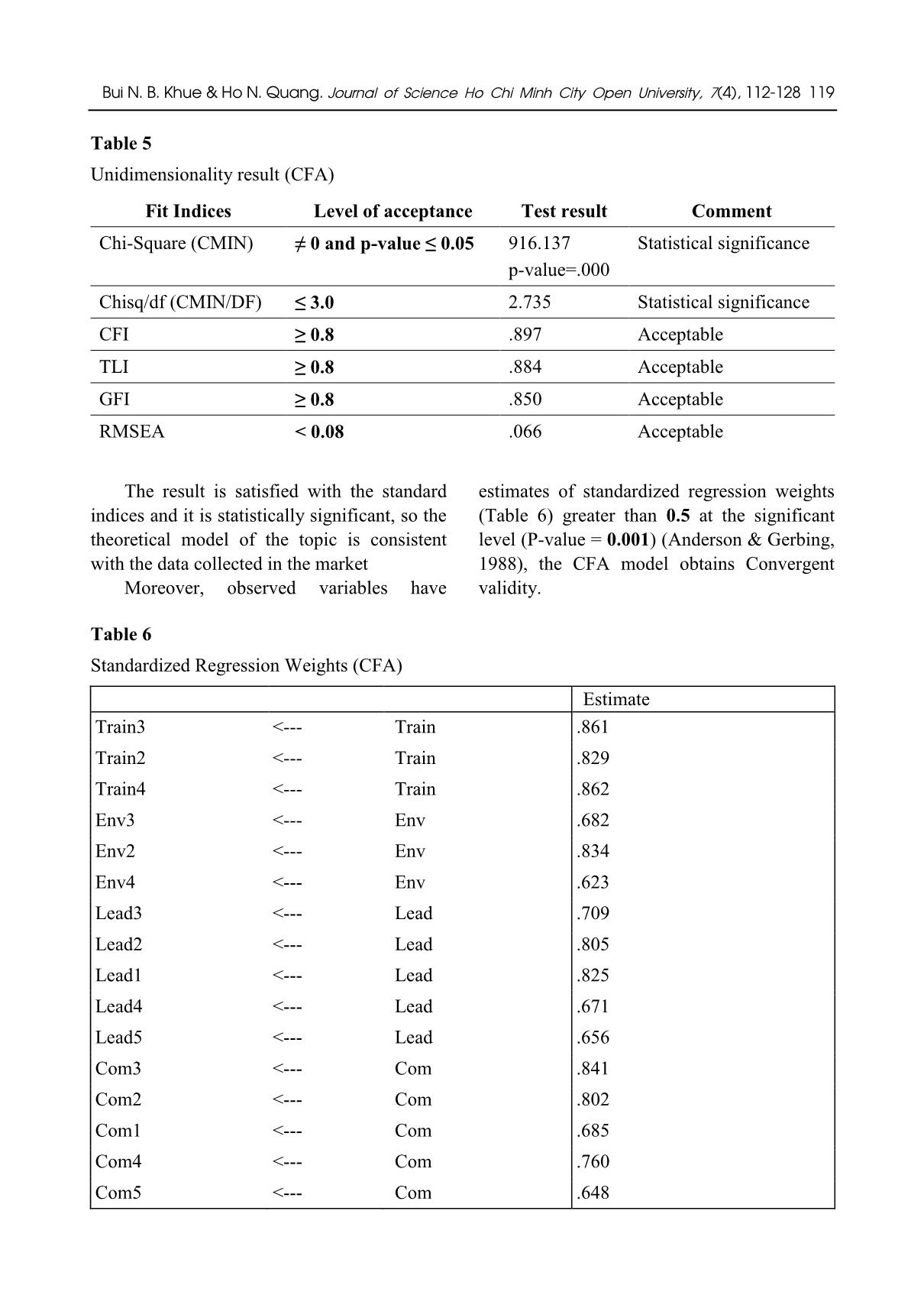
Trang 8
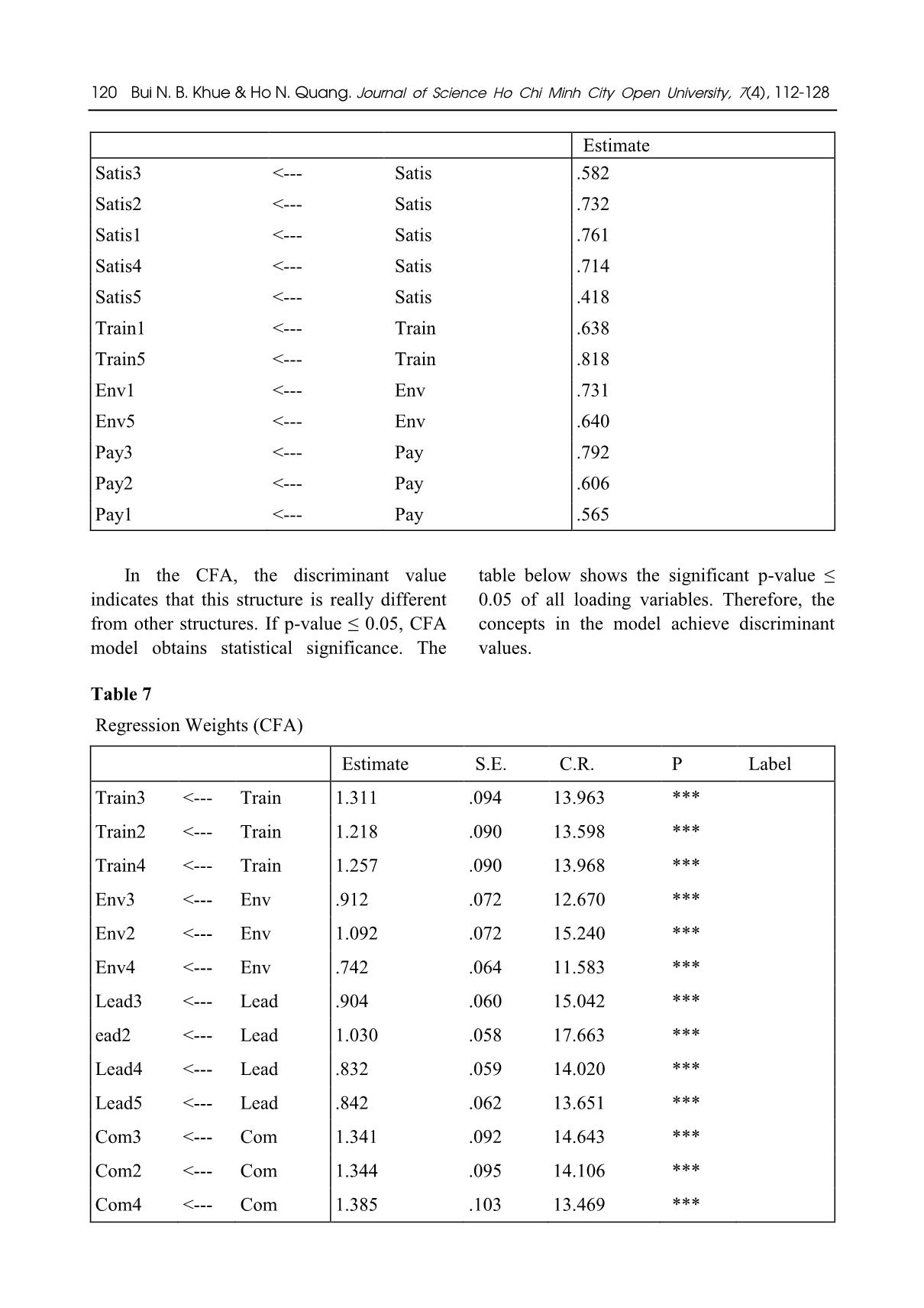
Trang 9
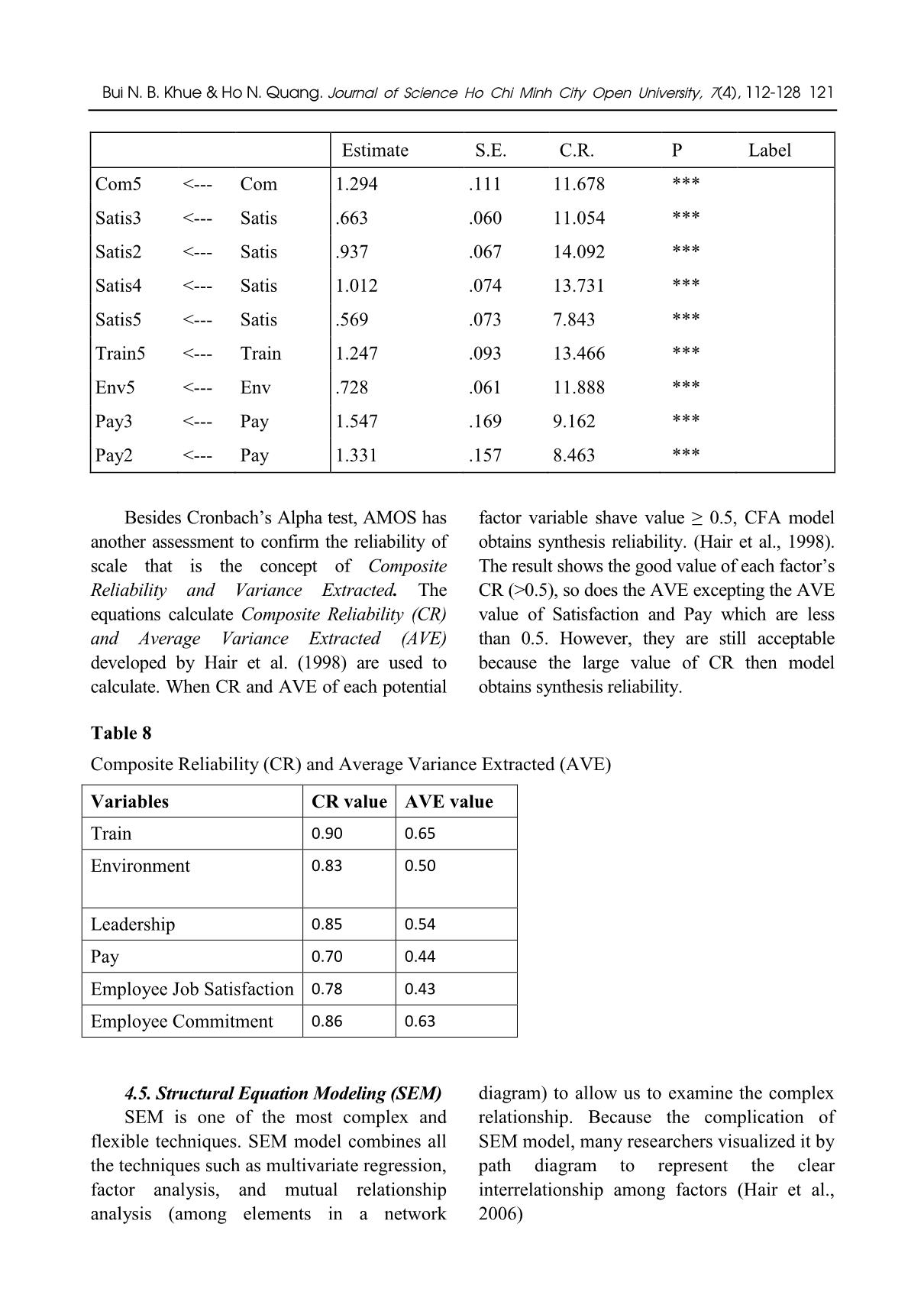
Trang 10
Tải về để xem bản đầy đủ
Tóm tắt nội dung tài liệu: Factors influencing employee commitment through the mediator job satisfaction - A study of office staffs in Ho Chi Minh city
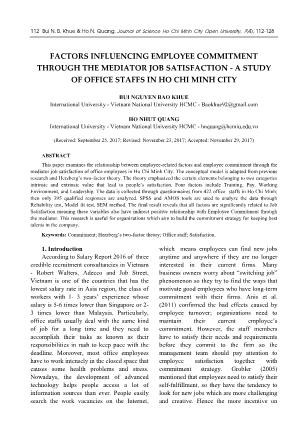
hrough the mediating variable Job Satisfaction. 5.2. The limitation of the study Firstly, this study just collected 395 samples of office staffs in Ho Chi Minh. It cannot cover all the Vietnamese companies. Secondly, because of the time limitation, data is collected by the open-ended questionnaire and the statements already listed for people to answer based on Likert Scale. The participants cannot provide their own opinions and evaluations. Finally, there are also many factors that affect the performance but not included in this study such as Job-itself, work- life balance etc. derived from Herzberg's theory. 5.3. Recommendation Leadership explains 35.8% to a variance of Job satisfaction. The organizations are not going to be successful if there is no contribution from each employee. Hence,. the management team should consult employees when making decisions that are relevant to their interests so that employees notice their necessary role within the company, and their dedication is valuable. Each leader continues learning, cultivating his or her leadership skills, timely modifies policies that cause employee dissatisfaction, designs feedback boxes that help employees freely contribute their ideas to leaders, thereby helping each other to increase work efficiency. Good worker does not always become a wise leader Bui N. B. Khue & Ho N. Quang. Journal of Science Ho Chi Minh City Open University, 7(4), 112-128 125 (Syptak, 1999). The supervisors have to cultivate leadership skills, treat people fairly and limit the negative comments. Working Environment has a positive relationship to Job satisfaction and increases commitment so the companies should facilitate for employees to work in a new environment if possible. For example, one or two days a week, they can sit next to their favorite colleagues or work outside the office. Company shall remodel the workspace to promote cooperation and creativity but still keep enough private space for each employee. It cannot be denied that salary and compensation are the most concern when entering the new company. Management team should always review the reward strategy in association with other factors that influence Job satisfaction such as companies’ recognition of employee’s good performance by giving monetary reward or HR departments’ regular review of base pay rate and flexible contingent pay. Key Performance Indicator is used not simply giving workers benefit but also promoting people in their career path which is an essential concern by employees. Furthermore, the improvement of the training program is also the method to retain key office employees. The training program ought to be designed as short, concise and with helpful content to reduce lassitude of employees. Moreover, Cross-Training should be applied since it decreases training cost for organization and increases the working process and peer relationship, Cross-Training is when organization create an opportunity for employees to enhance the proficiency levels beyond their ordinary responsibility and capture the workflow of other positions (Vasanthi, 2017). As long as the members of the group can understand other’s job, they are more willing to support when someone needs, thereby each worker can realize their latent strength References Abedi, G., Rostami, F., & Nadi, A. (2015). Analyzing the Dimensions of the Quality of Life in Hepatitis B Patients using Confirmatory Factor Analysis. Global journal of health science, 7(7), 22. Achieng’Nyaura, L., & Omwenga, D. J. (2016). Factors Affecting Employee Retention in the Hotel Industry in Mombasa County. Imperial Journal of Interdisciplinary Research, 2(12). Adams, G. A., & Beehr, T. A. (1998). Turnover and retirement: A comparison of their similarities and differences. Personnel Psychology, 51, 643−665. Akintayo, D. (2012). Working environment, workers ‘morale and perceived productivity in industrial organizations in Nigeria. Education Research Journal, 2(3), 87-93. Alshanbri, N., Khalfan, M., Noor, M. A., Dutta, D., Zhang, K., & Maqsood, T. (2015). Employees’ turnover, knowledge management and human recourse management: a case of Nitaqat program. International journal of social science and humanity, 5(8), 701. Anderson, J., Gerbing, W. (1988). Structural equation modeling in practice: A review and recommended two stage approach. Psychological Bulletin, 27(1), 5-24. Anis, A., Nasir, A., & Safwan, N. (2011). Employee retention relationship to training and development: A compensation perspective. African journal of business management, 5(7), 26-79. Bateman, T. S., & Strasser, S. (1984). A longitudinal analysis of the antecedents of organizational commitment. Academy of management journal, 27(1), 95-112. Bentler, P. M. (1990). Comparative Fit Indexes in Structural Models. Psychological Bulletin, 107, 238-246. 126 Bui N. B. Khue & Ho N. Quang. Journal of Science Ho Chi Minh City Open University, 7(4), 112-128 Beutell, N. J., & Wittig-Berman, U. (1999). Predictors of work–family conflict and satisfaction with family, job, career, and life. Psychological Reports, 85(3, Pt 1), 893−903. Bland J, Altman D. (1997). Statistics notes: Cronbach's alpha. Retrieved from <BMJ.;314:275. 10.1136/bmj.314.7080.572>. Brill, M., Weidemann, S., Olsen, J., Keable, E., & Bosti (2001). Disproving widespread myths about workplace design. Research report. Browen, M., & Cudeck, R. (1993). Alternative Ways of Assessing Model Fit, in Testing Structural Equation Models. Sage Publication. Browne, M. W., & Cudeck, R. (1993). Alternative ways of assessing model fit. Sage focus editions, 154, 136-136. Chen, H. C., & Baron, M. (2006). Nursing directors' leadership styles and faculty members' job satisfaction in Taiwan. Journal of Nursing Education, 45(10). Chung-Chieh, L., & Chen, C. J. (2013). The relationship between employee commitment and job attitude and its effect on service quality in the tourism industry. American Journal of Industrial and Business Management, 3(2), 196. Clement, A. (2000). Correlates of workers improved morale and productivity in organizations. Journal of Economic Studies, 8(2), 40-52. Croasmun, J. (2004). Comfort Means Productivity for Office Workers [online]. Retrieved from Dawley, D. D., Andrews, M. C., & Bucklew, N. S. (2010). Enhancing the ties that bind: mentoring as a moderator. Career Deveoplement International, 15(3), 259-278. DeVellis R. (2003). Scale development: theory and applications: theory and application. Thousand Okas, CA: Sage. Dunham, R. B., & Hawk, D. L. (1977). The four-day/forty-hour week: Who wants it? Academy of Management Journal, 20, 644−655. Dunnette, M. D., & Hough, L. M. (1991). Handbook of industrial and organizational psychology, Vol. 2. Consulting Psychologists Press. Efron, B. (1979), Bootstrap methods: Another look at jackknife, Ann. Stat, 7, 1-26. Feinstein, A. H., & Vondrasek, D. (2001). A Study of Relation- ships between Job Satisfaction and Organizational Commitment among Restaurant Employees. Journal of Hospitality, Tourism, and Leisure Science, 1(4), 1-20. Flippo, E. B. (1987). Personnel Management, 6th Edition, Singapore McGraw – Hill Book Company, 227- 245. Gaertner, S. (1999). Structural Determinants of Job Satisfaction and Organizational Commitment in Turnover Models. Human Resource Management Review, 9(4), 479-493. Gardner, D. G., Dyne, L., & Pierce, J. L. (2004). The effects of pay level on organization-based self-esteem and performance: a field study’. Journal of Occup. Organ. Psychology, 77(3), 307-322. Greene, R. J. (2010). Effectively Managing Base Pay: Strategies for Success. Retrieved from the Society for Human Resource Management. Grobler, P.A. (2005). Human Resource Management in South Africa, 3rd Ed, London: Cengage Learning EMEA. Hair, J. F., Black, W. C., Babin, B. J., Anderson, R. E., & Tatham, R. L. (1992). Multivariate Data Analysis. J. Marketing, 54(2) 46–56. Hassan, A. R., Qamar, R., Jaffir, R., & Sidra Suhail, W. (2013). The effect of training on employee retention. Global Journal of Management and Business Research, 13(6). Heneman, H. G., III, & Judge, T. A. (2000). Compensation attitude. In S. L. Rynes & B. Gerhart (Eds.), Compensation in organizations: Current research and practice, 61−203. Bui N. B. Khue & Ho N. Quang. Journal of Science Ho Chi Minh City Open University, 7(4), 112-128 127 Herzberg, F., Mausner, B., & Snyderman, B. B. (1959). The Motivation to Work. Retrieved on February 18, 2013 from Hoppock, R. (1935). Job satisfaction. Oxford, England: Harper. Hu, C., & Wang, Y. (2010). Bootstrapping in AMOS. Powerpoint. Consulté le, 23-02. Hulin, C. L. (1991). Adaptation, persistence, and commitment in organizations. Retrieved from . Jermier, J. & Berkes, L. (1979). Leader behavior in a police command bureaucracy: A closer look at the quasi- military model. Administrative Science Quarterly, 24, 1-23. Judge, T. A., Piccolo, R. F., Podsakoff, N. P., Shaw, J. C., & Rich, B. L. (2010). The relationship between pay and job satisfaction: A meta-analysis of the literature. Journal of Vocational Behavior, 77(2), 157-167. Kohun, S. (1992). Business environment. Ibadan: University Press. Koikai, P. K. (2014). Motivational factors influencing employee retention in multi purposes training institutions: a survey of selected institutions in Kenya. Doctoral dissertation, University of Nairobi. Kulkarni, P. P. (2013). A literature review on training & development and quality of work life. Researchers World, 4(2), 136. Lam, T., Baum, T., & Pine, R. (2003). Subjective Norms: Effectives on Job Satisfaction. Annals of Tourism Research, 30(1), 160-177. Locke, E. A. (1976). The nature and causes of job satisfaction. Handbook of industrial and organizational psychology. Malka, A., & Chatman, J. A. (2003). Intrinsic and extrinsic orientations as moderators of the effect of annual income on subjective well-being: A longitudinal study. Personality and Social Psychology Bulletin, 29, 737−746. Mat, J. (2008). The Influence of Leadership Style on Internal Marketing in Retailing. PhD Thesis. University of Stirling. McClelland, D. C. (1980). Motive dispositions: The merits of operant and respondent measures. Review of personality and social psychology, 1, 10-41. Meyer, J. P., & Allen, N. J. (1991). A three-component conceptualization of organizational commitment. Human resource management review, 1(1), 61-89. Michigan Organizational Assessment Package (1975). Ann Arbor: Institute for Social Research, University of Michigan. Milkovich, G. M., & Newman, J. M. (2004). Compensation (8th ed.). Burr Ridge, IL: Irwin McGraw-Hill. Mincer, J. (1962). On-the-Job Training: Costs, Returns, and Some Implications. Journal of Political Economy, 70(5), 50-79. Mohammad, M. A., & Hossein, Y. M. (2006). A study of relationship between managers' leadership style and employees' job satisfaction. Leadership in Health Services, 19(2), 11-28. Mowday, R.T., Porter, L.W., and Steers, R.M. (1982). Employee-Organization Linkages: The Psychology of Commitment, Absenteeism and Turnover. San Diego, CA: Academic Press. Moyes, G. D., Cortes, A. C., & Lin, P. (2007). Determinants of job satisfaction and retention of Mexican-American accounting professionals. Journal of Business & Economics Research, 5(5), 77-88. Msengeti, D. M., & Obwogi, J. (2015). Effects of Pay and Work Environment on Employee Retention: A Study of Hotel Industry in Mombasa County. International Journal of Scientific and Research Publications, Volume 5, Issue 4, April 2015 Nunnally, J. C., & Bernstein, I. H. (1994). Psychometric theory (3rd ed.). McGraw-Hill, Inc New York, NY. Okumbe, J. A. O. (1998) Educational Management: Theory and Practice. Nairobi University Press Opperman C. S. (2002). Tropical business issues. Partner Price Water House Coopers. 128 Bui N. B. Khue & Ho N. Quang. Journal of Science Ho Chi Minh City Open University, 7(4), 112-128 Payne, H. J. (2005). Reconceptualizing social skills in organizations: Exploring the relationship between communication competence, job performance, and supervisory roles. Journal of Leadership & Organizational Studies, 11(2), 63-77. Sanchez, J. I., & Brock, P. (1996). Outcomes of perceived discrimination among Hispanic employees: Is diversity management a luxury or a necessity? Academy of Management Journal, 39, 704−719. Shrout, P. E., & Bolger, N. (2002). Mediation in experimental and nonexperimental studies: New procedures and recommendations. Psychological methods, 7(4), 422-445. Siebern-Thomas, F. (2005) Job quality in European labour markets, in Bazen S., Lucifora C. and Salverda W. (Eds.), Job Quality and Employer Behaviour, Palgrave Macmillan, Basingstoke, Hants, 31-66. Silbert, L.T. (2005). The effect of Tangible Rewards on Perceived Organizational Support. Management Sciences. Retrieved from . Smith, P. C., Kendall, L. M., & Hulin, C. L. (1969). The measurement of satisfaction in work and retirement, Chicago: Rand McNally. Stanley, B. (2003). Middle level manpower development, skill acquisition and utilization in industries. Journal of Organizational Behaviour, 8(2), 47-53. Syptak, J. M., Marsland, D. W., & Ulmer, D. (1999). Job satisfaction: Putting theory into practice. Family Practice Management, 6(9), 26. Talentnet and Mercer Total Remuneration Survey (TRS) (2016). Retrieved from < survey-trs-2016--cPirchp92X>. Tucker, L. R. & Lewis, C. (1973). The reliability coefficient for maximum likelihood factor analysis. Psychometrika, 38, 1-10. Turkyilmaz, A., Akman, G., Ozkan, C., & Pastuszak, Z. (2011). Empirical study of public sector employee loyalty and satisfaction. Industrial Management & Data Systems, 111(5), 675-696. Vasanthi, S. & Rabiyathul, B.S. (2017). Cross Training Employees – A Conceptual Review. International Journal of Advanced Research in Science, Engineering and Technology, 4(3). Wakabi, B. M. (2013). Leadership Style and Staff Retention in Organizations. International Journal of Science and Research (IJSR) ISSN (Online): 2319-7064. Wells, M. &Thelen, L. (2002). What does your workplace say about you? The Influence of personality status and workplace on personalization. Journal of Environmental and Behaviour Sciences, 34(3), 300-321. Wells, M. &Thelen, L. (2002). What does your workplace say about you? The Influence of personality status and workplace on personalization. Journal of Environmental and Behaviour Sciences, 34(3), 300-321. Yusuf, N. & Metiboba, S. (2012). Work environment and job attitude among employees in a Nigerian work organization. Journal of Sustainable Society, 1(2), 36-43.
File đính kèm:
 factors_influencing_employee_commitment_through_the_mediator.pdf
factors_influencing_employee_commitment_through_the_mediator.pdf

